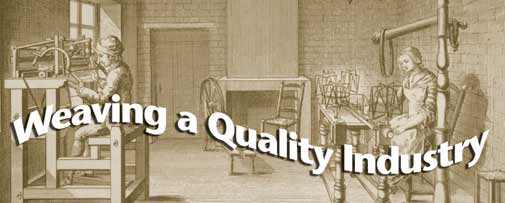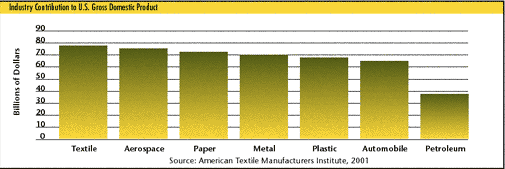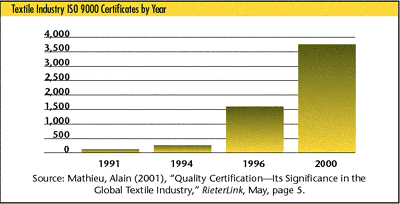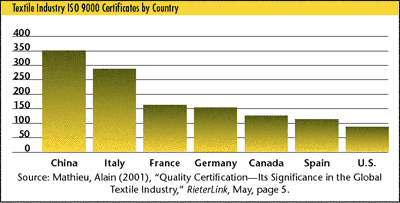|
|
|
|
Today's Specials |
|
||
|
||
|
||
Article

Quality initiatives reshape the textile industry.
________________________________________________________________ Modern fiber, textile and apparel industries are complex, high-tech trades invested with numerous competitive challenges. To cope with these, many of the nearly 30,000 textile-related companies in the United States have implemented quality management initiatives to lower costs and improve both products and customer satisfaction. A wide variety of quality methods and many different levels of implementation are used; some companies still rely on centuries-old final-inspection techniques, but other organizations can be counted among the most advanced in any industry. Today, the fiber, textile and apparel industries account for about 7 percent of all manufacturing jobs in the United States. Combined, these industries employ 1.2 million people directly and support more than 2.4 million other jobs. This massive industrial complex is the largest contributor among basic manufacturing industries to the U.S. gross domestic product. During the past 10 years, textile-related industries have invested more than $2 billion annually in new technologies and equipment. This investment has driven remarkable productivity increases. Productivity in weaving per loom hour, for example, increased more than 500 percent between 1975 and 1999. This sharply contrasts with overall U.S. manufacturing productivity, which has more than doubled since 1970.1
Trade challenges The fiber, textile and apparel industries are in the midst of radical changes. Global competition is intense. Although the United States is the world's seventh-largest exporter of textiles and has increased exports by 15 times its 1970 rate, an astoundingly rapid growth of imports, especially in apparel, has caused a major trade deficit. The U.S. textile trade deficit rose 10.4 percent in 1999 and accounted for 1.2 percent of the country's total trade deficit. The apparel trade deficit increased 7.1 percent and now accounts for 14 percent of the total. With only 4.3 percent of the world's population and 16 percent of the world's textile-mill output, the United States consumes nearly 20 percent of the world's textiles and receives close to 20 percent of the world's textile and apparel imports.2 The industries' markets are becoming more complex. Short life cycles are common, and demands for rapid response and just-in-time delivery are increasing. There are still many hand-offs in the production and delivery processes, and few companies are able to control the entire process. As competition continues to increase, U.S. fiber, textile and apparel companies must rely more on superior quality, innovative products and rapid response to customer needs to secure markets and continue to grow. Breakthroughs in nanosciences, electrotextiles, nonwovens, medical textiles and geotextiles are providing new hope and new challenges. But all of the resulting new products require even higher quality levels and production-control techniques.
Textile standards, B.C. and A.D. The textile industry is one of the world's oldest. The earliest known textiles include scraps of linen cloth found in Egyptian caves dating from about 5000 B.C. In the western world, textile manufacturing remained a family business until the early 1500s, when the first factories were built. In Asia, especially China, centralizing and standardizing textile production occurred as early as the Zhou Dynasty (11th to eighth centuries B.C.). Very explicit stipulations and standards existed for silk and cotton fabrics. One dynasty decree stated, "Cottons and silks of which the quality and size are not up to the standards are not allowed to be sold on the market." The later Zhou Dynasty even incorporated separate warp and weft standards for silk in the north and south because of differing weather and humidity. Textile producers who didn't meet these exacting standards were penalized and punished.1 In the West, an early regulation for quality assurance in the textile trade dates back to 14th-century Germany. Called tuchshau ("showing of cloth"), the regulation involved expert inspectors who, along with an equal number of city council members, observed the entire manufacturing process starting at the loom, where warps were inspected. No piece of cloth could be sold unless it was produced under this supervision.4 As in most other manufacturing industries, for many centuries quality in the textile industry was achieved through final inspection of finished goods. This final inspection was often used to create different grades of quality, products of which were then sold at various prices. Manufacturers slowly began to add inspection and control to the quality of raw materials and the production processes.
Enter statistical process control The first reports on statistical quality control of yarn-manufacturing products appeared during the late 1940s and 1950s. These documents emphasized product quality and defect detection rather than defect prevention. At that time, quality assurance was very much a departmentalized function. Unfortunately for many companies in the textile industry, this condition still exists. In spun-yarn manufacturing, testing focused on three areas: end-product testing of characteristics such as linear density, twist, strength and elongation, short-term evenness, and count variation; inspection of defects such as thick and thin places, slubs and neps, and repeating faults like mechanical errors or drafting waves; and frequency checks for end breaks during spinning. In recent years, companies have begun to focus on electronic monitoring of processing weights, faults and running performance.5 However, one of the problems many companies using electronic monitoring and controls face is that the adjustments are made on predetermined target values rather than through statistical control limits. This often leads to far more variation when overcontrol is added to the process. Another critical test for yarn production occurs in the filament and texturing areas. Here, chemical and mechanical properties are important. Tested characteristics include dyeability, yarn crimp, contraction and permanence, package density and build, strength and elongation, and shrinkage. Modern companies seek to control the factors in the process that produce these characteristics; for example, consistent tensions and temperatures during texturing will lead to more consistent dye uptake in textured yarns.6 Statistical process control is also used in woven-, knitted- and nonwoven-fabric manufacturing. Many companies still focus on defect detection, sorting, situation resolution and other firefighting activities, although the recent trend has been toward continuous improvement and prevention. The relationship between yarn and fiber quality and the final fabric's quality is now better understood and managed. The third area of SPC in textiles is in dyeing and finishing. Dyeing a textile yarn or fabric is one of the most difficult, monitored and controlled processes in the textile manufacturing chain. The finishing process, by contrast, still has few controls and relies heavily on inspection and testing. The two main processes used in finishing are chemical and mechanical. Evaluating the results of both these methods is still highly subjective, and very little SPC has been applied in these areas. There are difficulties when using online quality controls and advanced control charts in textile manufacturing. Because many steps in textile manufacturing are dependent, as are many of the quality characteristics, dynamic control isn't feasible without new methods to handle these problems.7 But steady progress has been made. As early as 1949, companies were looking for a way to compare yarns. Zellweger, a textile manufacturer located in Uster, Switzerland, starting collecting data at the international level. In 1997, statistical information about twist statistics using new methods from the Swiss Textile Testing Institute was added to the 40th edition of the resulting database. Yarn count, strength, elongation, twist, uniformity, coefficient of friction and hairiness are now all regularly analyzed.8 In 1992, a new benchmark test for the Eco-Tex Standard 100 for human ecology-optimized textiles was introduced. This standard specifies minimum requirements for textiles that aren't harmful to human skin. By the end of 2000, more than 20,000 Eco-Tex certificates had been issued to textile manufacturers throughout the world. A related problem in textile manufacturing concerns the quality of raw materials in relation to the final product's quality. When raw materials include natural resources such as cotton, controlling quality can be quite difficult. For many years, classifying cotton quality was a subjective and labor-intensive process. In 1969 the U.S. Department of Agriculture began developing instruments capable of rapidly and objectively making these classifications. Today all U.S. cotton is classed using this system. In 1982, Cotton Inc. introduced the Engineered Fiber Selection cotton fiber management system. Consequently, cotton mills have been able to lower cost and improve product quality. Essentially all mills spinning cotton in the United States now use this system.
Spinning ISO 9000 The textile industry, especially in the United States, has recently begun to use the ISO 9000 series of standards as a quality assurance system, though registration is still seen by many companies as only necessary as a factor for exports. Ten years ago there were fewer than 100 textile companies registered. By 1996 the number had soared to 1,600, and by the end of last year, there were 3,673 registered textile companies. The number of ISO 9000 certificates in the textile industry increased 29.6 percent from 1998 to 1999. China, Italy, France and Germany lead the world in numbers of certified textile companies, whereas only a few of the more than 30,000 U.S. companies have been registered. With the publication of the ISO 9000:2000 revision, more textile companies will likely find value in using the standards as the basis for their quality assurance systems. Also, an increase of both imports and exports from U.S. fiber, textile and apparel industries will make adopting the standards more critical. The new standards have many advantages over the original series published in 1987 and updated in 1994. These include a focus on a process model, continuous improvement and customer satisfaction. The revision also includes eight management principles similar to the Malcolm Baldrige National Quality Award and European Quality Award criteria. These can be summarized as customer-focus, leadership, people involvement, process approach, system approach to management, continual improvement, factual approach to decision making, and a mutually beneficial suppliers relationship.
Total quality management At the very top end of the industry spectrum stands one of the largest textile companies in the world, Milliken & Co. In 1981, the company's senior management launched its Pursuit of Excellence initiative, a commitment to customer satisfaction pervading all company levels and locations. By 1989 Milliken & Co. was ahead of its competition in all 15 measures of customer satisfaction and won the Baldrige Award. Milliken & Co. has consistently compared itself to the best-managed companies in the world and has incorporated the best practices from them. It now has an extremely flat organizational structure with self-managed teams in all areas of the business. Milliken has released almost 20 percent of management and engineering positions to create an enviable strike force of process-improvement specialists. The company has perfected the use of improvement teams to address specific problems and to change and improve processes in all areas of the company. Milliken & Co. also has been a leader in building measurement systems and making decisions based solidly on factual information. It has also realized that quality management extends to all work processes. For example, by the time the company won the Baldrige Award, it had improved on-time delivery from 75 percent in 1984 to an industry best of 99 percent in 1988.9 Another area where Milliken & Co. continues to set the standard is in associate involvement. Last year it averaged more than 92 suggestions per associate and implemented more than 85 percent of all those received. Supply-chain management and lean thinking Intense competition, both nationally and globally, has caused a new focus on quality management in textile companies. An influx of senior management from outside the industry has brought some new methods into the industry, but most initiatives have come from companies within the industry looking at all avenues of improvement. One of the first things many of the new senior managers noticed was their companies' enormous inventories. The number of inventory turns per year in textiles remains among the lowest of all industries. Supply chains are extremely long and complex, and products are routinely stored, loaded and shipped many times during the production cycle. Warehouses represent a large part of the space and costs in the textile manufacturing process. The Harvard Center for Textile and Apparel Research documented many of these stages for apparel manufacturers in a landmark study funded by the Sloan Foundation and published in 1999. For some companies, such as Milliken & Co. and Burlington Industries, implementing supply-chain management has become a No. 1 priority. Special projects in reducing inventories, creating fast response strategies and cutting product development times are now common in many leading companies.
Six Sigma and beyond As in other industries, the leading fiber, textile and apparel companies continue to search for new ideas and methods for improving quality, reducing costs and increasing productivity. Several of these companies have been leaders in implementing Six Sigma quality programs. One of the first to follow Motorola's lead in implementing Six Sigma was AlliedSignal (now Honeywell) under the direction of Larry Bossidy. AlliedSignal has led fiber production for years. DuPont quickly followed and has made Six Sigma a key part of its management strategy. DuPont uses the program for its productivity and quality improvement strategies. It considers Six Sigma a business-management process that concentrates on eliminating defects from work processes. The company now has more than 4,000 completed or in-process Six Sigma projects. Some of these have lessened the company's environmental impact or increased safety. At one U.S. plant, one such project saved 50 billion BTUs by reducing the amount of purchased steam unnecessarily condensed and lost to drainage. At a DuPont site in the People's Republic of China, a project helped reduce electricity consumption and carbon dioxide emissions. DuPont estimates that one in every 10 employees will be involved in such projects in the near future. It expects the resulting enhancements will be major drivers of the company's growth efforts. Other textile companies, such as Burlington Industries, Unifi, Collins and Aikman, and PGI have also started Six Sigma initiatives. The leading fiber, textile and apparel companies will always continue to search for ideas and methods in quality management that create competitive advantage. The speedy implementation of the right methods will make a significant and successful difference in many of these companies' futures.
References 1. Siekman, Philip. "The Big Myth About U.S. Manufacturing." Fortune, Oct. 2, 2000. 2. American Textile Manufacturers Institute. "Economic Developments in the Textile Industry." Washington, D.C.: Office of the Chief Economist, September, 2000. 3. Qiupeng, Jin; Meidong, Chen; and Wenzhao, Lin. "Ancient China's History of Managing for Quality," A History of Managing for Quality. J. M. Juran, editor in chief. Milwaukee: ASQ Quality Press, 1995. 4. Lerner, Franz. "History of Quality Assurance in Germany," A History of Managing for Quality. J. M. Juran, editor in chief. Milwaukee: ASQ Quality Press, 1995. 5. Johnson, Roy. "The Application of SPC in the Textile Industry," Statistical Process Control, Practical Guides for Measurement and Control. Research Triangle Park, NC: Instrument Society of America, 1995. 6. Ibid. 7. Suh, M. W. "Quality Improvement Approaches in the Textile Industry." Anaheim, CA: American Statistical Association meeting, Aug. 6-9, 1990. 8. Haug, Jean-Pierre and Meili, Adrian. "Quality Testing and International Benchmarking of Quality in the Textile Sector." RieterLink, Vol. 13, No. 33. May, 2001. 9. National Institute of Standards and Technology. "Winners Showcase." www.quality.nist.gov/winners/milliken.htm: Aug. 25, 2000.
About the authors The authors are all members of North Carolina State University's College of Textiles. Timothy G. Clapp, Ph.D., is professor and associate head and coordinator of undergraduate programs, textile engineering, chemistry and science. A. Blanton Godfrey, Ph.D., is dean and Joseph D. Moore professor. Dale Greeson is a graduate student in textile engineering. Roy H. Johnson, Ph.D., is an extension specialist. Coleman Rich is director of short courses. Cliff Seastrunk is director of textile extension and applied research. E-mail the authors at textilequality@qualitydigest.com .
|
Menu Level Above
This Menu LeveL
Menu Level Below
Copyright 2001 QCI International. All rights reserved.
Quality Digest can be reached by phone at (530) 893-4095. E-mail: Click Here





